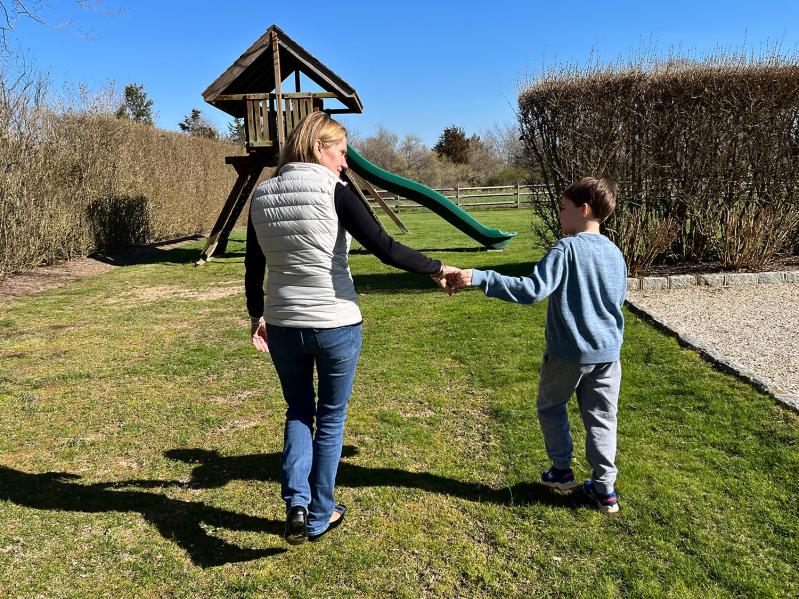Autism spectrum disorder was a 1-in-150 diagnosis in the year 2000 among children in the United States, a figure that plunged to 1 in 44 in 2018. Today, 1 in 36 children has some form of autism, the Centers for Disease Control and Prevention said in March.
Advocacy organizations like the ADNP Kids Research Foundation and physicians like Dr. Alex Kolevzon, a child and adolescent psychiatrist and professor of psychiatry and pediatrics at Mount Sinai Hospital’s Icahn School of Medicine, are strongly encouraging families of children with autism to get genetic testing — not just in April, which is Autism Awareness Month, but as a standard practice in this branch of medicine.
“Knowledge is power,” said Dr. Kolevzon, the clinical director of the Seaver Autism Center, who sees at least one South Fork family, the Egerton-Warburtons of Water Mill, in his practice.
“Most of the current efforts revolve around understanding the genetics of autism, because every time a new gene is identified that we know causes it, it gives insight into the biology of the condition,” he said in an interview. “It may be able to help predict some of the course of the illness, and potentially what other risks you may have. You become part of a community with shared issues, which is really important for families. . . . It’s important that once you get the diagnosis, you get the genetic testing.”
The stigma attached to an autism diagnosis is slowly — very slowly — being erased, said Dr. Kolevzon, who in 2020 received the “RARE Champion of Hope Award” from an organization called Global Genes Allies in Rare Disease. “When I first started in this field about 20 years ago, to kind of suggest gently to families that perhaps their child is affected by autism would be really devastating,” he said. “Now with better treatments, more awareness, and more routine screenings, families are much more likely to seek out a diagnosis, because it’s a path toward access to services.”
His young Water Mill patient, Rowland Egerton-Warburton, is 10 years old now. He attends elementary school in Southampton for about an hour each weekday to receive speech, occupational, and physical therapy, and other support from the district’s “wonderful team of related service providers,” with whom his parents, Jamie and Genie Egerton-Warburton, have been extremely happy. The rest of the time he is with his family, his nanny, or Christy DeLorenzo, a one-on-one special-education teacher and board-certified behavior analyst. Their services are coordinated and paid for by the school district; all New York public schools are required to provide a “free and appropriate education” for children, regardless of their level of ability.
Rowland has ADNP syndrome, also known as Helsmoortel-Van Der Aa Syndrome. The diagnosis, in 2016, of this rare neurodevelopmental disorder lands him on the autism spectrum. Autism is just that, doctors say — a spectrum with a rainbow-like range of sensory sensitivities, perceptive abilities, social differences, executive-function abilities, emotional regulation, and other factors.
Roly, as his family calls him, is small for his age and knows a limited number of words, but his eyes are a cheerful blue and his smile sparkles as he and his mother clap and move their feet around their sunny backyard to a lively rendition of “The Ants Go Marching” on a recent afternoon. Among his other skills are high-fives, which he sweetly offers a visitor, and swimming. He also loves car rides and going grocery shopping. The goal is for him to gradually learn new skills and behaviors so that he can spend more time with his therapists at school and eventually enter an integrated classroom where he can form friendships with peers.
An autism diagnosis can be an ever-changing experience for children and their families. Lately, the Egerton-Warburton family’s focus is on care that will help Rowland “find peace and calmness in his own body in order to sleep and learn.”
“There’s nothing typical about having a child who is autistic,” said Ms. Egerton-Warburton, the vice president of the ADNP Kids Research Foundation and a former prekindergarten teacher with a degree from the Bank Street College of Education. “You have to make accommodations and try your hardest — one foot in front of the other — and have hope. My expectations aren’t, he has to read, or draw a straight line. To me, the most important thing is he feels loved, cared for, accepted, part of society, validated, and included.”
Both Rowland and his older sister Charlotte, 12, who helped raise money for the ADNP Foundation by making mask necklaces during the height of the pandemic, have undergone the kind of genetic testing that doctors are increasingly urging, sharing skin, hair, and blood samples on multiple occasions. At one time, their mother said, the tests could cost as much as $13,000. Now, said Dr. Kolevzon, thanks to advances in technology and improvements in insurance coverage, they can cost as little as “a couple hundred bucks.”
For a family of a child with autism, the testing can be priceless. It can pave the way for a brighter, more optimistic future, not only for their own child but for other autistic children, as the understanding of genetics and care evolves and improves.
“I’m extremely hopeful. I’ve seen profound changes in the field in the last 20 years,” Dr. Kolevzon said. “We’ve seen enormous advances in our knowledge, exponential increases in discovering new genes, . . . Science is changing, and learning more and more. Everything that people are doing is in the service of developing treatments and understanding the conditions. I think everyone should feel hopeful.”

